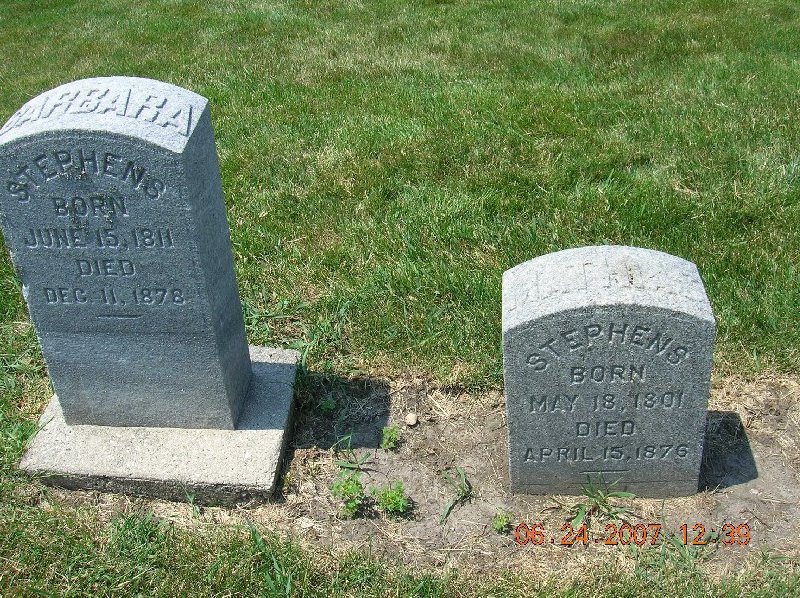My great-great-great-grandfather, James A. Baldwin, was a blacksmith who made his home with his wife, Susan, in Cannon, Kent Co., Michigan. In 1872, when he was only 38, he was killed in a gun accident.
According to a news account, "Last Sabbath, Mr. J. A. Baldwin, of this village, in company with another person, were going out in a buggy, hunting. When about 3 miles out on the State road, and while stopping to talk with a man, the gun dropped down through the buggy, (a skelton,) and, probably striking the axle tree, discharged itself killing Mr. Baldwin instantly. The deceased is said to have been a first-rate mechanic, but of intemperate habits. We learn that he left a wife and six children, in very destitute circumstances." (Rockford Weekly Register, Nov. 13, 1872)
James and Susan were the parents of three daughters -- Elizabeth, Nellie, and Maude, and four sons --James, Harry, Eudoras, and Ralph.
The first son, James, appears to have died before 1872. A biography of the second son, Harry, says he "early assisted in his father’s shop where he became a skilled artisan as did two of his brothers." (A Third Volume Devoted to Kent County, 1924).
Public records show that the Baldwin brothers worked as blacksmiths throughout their lives. In 1880, Harry was married and working as a blacksmith in Grattan. My great-great-grandfather Eudoras (Dora), was living with Harry and his wife, and also working as a blacksmith. Ralph worked as a blacksmith in Luther, Michigan in the mid-1880s. Dora then operated a blacksmith shop in Rockford for many years. He was self-employed as a "Carriage & wagon mnfr & blacksmith" according to the 1884 Western Michigan Directory.
 |
| An advertisement in the Grand Rapids Press, 1913 |
Public records show that the Baldwin brothers worked as blacksmiths throughout their lives. In 1880, Harry was married and working as a blacksmith in Grattan. My great-great-grandfather Eudoras (Dora), was living with Harry and his wife, and also working as a blacksmith. Ralph worked as a blacksmith in Luther, Michigan in the mid-1880s. Dora then operated a blacksmith shop in Rockford for many years. He was self-employed as a "Carriage & wagon mnfr & blacksmith" according to the 1884 Western Michigan Directory.
About 1881, Dora married my great-great-grandmother Hattie, and they soon had two children. The family was together in 1894, but in 1900, Hattie and her children were living in Grand Rapids, and Dora was living and partnering with his brother-in-law, George Crakes in Charlevoix. Ralph, who had married in 1888, appears to have separated from his wife. Over the years, Dora and Ralph moved around, going back and forth between southern and northern Michigan.
In 1891, Harry moved to Grand Rapids where he would stay the rest of his life. He established a blacksmith business there and over time, became a substantial citizen in the city. Harry patented the Baldwin ice tongs and by 1915, was employing seven men in "manufacturing, building wagons, making chain, ice tongs, and other ironmongery." (History of Michigan, Volume 4, 1915)
 |
| An advertisement in the 1916 Grand Rapids City Directory |
Harry ran for office and was elected alderman in 1903. He served a total of fourteen years as alderman, then served as commissioner for two terms. "He takes deep interest in all that concerns the welfare of his home city and native county, and here he has a secure place in popular confidence and esteem." (A Third Volume Devoted to Kent County, 1924)
 |
| An article in the Grand Rapids Press, 1907 |
While Harry was a picture of civic responsibility, Ralph appears to have followed a different path. A newspaper headline proclaimed "Too Fond of Drink" and went on to explain, "A little punishment evidently fails to satisfy Ralph Baldwin of Solon Center. Wednesday, shortly after finishing a jail sentence for being drunk he was arrested again by the police and Judge Hess fined him $5 and costs, which he paid." (Grand Rapids Press, July 27, 1906)
The last record I have found of Dora is the 1920 census, where he was living in Norman, Michigan, and working in a blacksmith shop. He was listed as "Widowed." Meanwhile, on the same census, his wife, Hattie, was working as a housekeeper in Courtland, Michigan, and was listed as "Married."
 |
| A unique family heirloom - the Baldwin ice tongs, passed down to me and hanging in my kitchen |



































